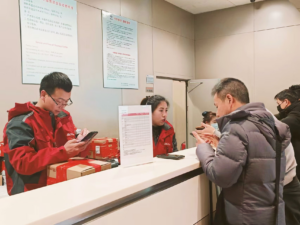Feb 28, 2020|
In-Depth Report: In Retrospect and Outlook: How JD Made It?
by Rachel Liu
On March 6, 2003, the first case of SARS (Severe Acute Respiratory Syndrome) was reported in Beijing. JD Multimedia, an offline company that mainly sold magneto-optical products in Zhongguancun, Beijing found itself in trouble. As customers dared not to go out to shop in the malls, the retail industry suffered a heavy blow, and in just 21 days, JD Multimedia lost more than eight million RMB. Certain that things could not continue this way, the company started to sell products through online postings. It was a huge success, and, in 2004, JD became a 100% online retail company.
In January 2020, COVID-19 (the “coronavirus”), a highly contagious virus believed to be similar to SARS, struck China. JD.com is already the largest retailer in China, online or offline and in a very different position than it was in in 2003. The company is now able to use the massive scale of its retail business, mature supply chain and logistics capability to support the fight against coronavirus.
First there was SARS
Retail has been in JD’s blood from the beginning. In 1998, JD Multimedia, the predecessor of JD.com, was engaged in a classic offline business: stocking and selling goods, first wholesale, then retail. At that time, the market was full of chaos and corruption. At the stores in Zhongguancun, authentic goods and knock-offs were sold side-by-side, making it hard for customers to pick authentic and authorized products.
JD’s founder Richard Liu took a different approach from many sellers in Zhongguancun. The company only sold authentic products at reasonable prices. As time went by, it accumulated a group of loyal customers. After moving the business entirely online in 2004, it was the reputation of authenticity that attracted the first group of customers to JD. The retail model enables JD to work directly with brand partners to source products, and to store them in its own warehouses, meaning it has higher control of product quality and can guarantee authenticity.

In 2007, JD stepped further in building its own supply chain—establishing its self-built logistics system and realizing the integration of warehousing and delivery. Many people would think that JD and Amazon share many similarities. Both adopted a retail model, controlling the supply chain. However, the building of the logistics network is what makes JD standout in the Chinese market. Different from the U.S., at the time, China did not have a nationwide logistics system, and the logistics industry was highly fragmented. At that time, half of the customer complaints that JD received were logistics-related: some people complained that the delivery was too slow, while others said that the parcels they received were damaged. This is because rough loading and unloading was common for logistics companies, and the electronics products that JD sold could not withstand this kind of treatment.
To provide a better customer experience, Richard Liu decided that the solution was to build its own logistics infrastructure, including delivery service. It was a controversial decision since it would require a huge amount of investment. However, Liu insisted on forging ahead because he believed this was the only way JD could control the entire supply chain and continue to provide high-quality service. In 2010, JD launched a delivery guarantee called “211”, also referred to as same- or next-day delivery. It guarantees that if customers place orders before 11am, they will receive products the same day, and if they place an order before 11pm, they will receive them before 3pm the next day. No other e-commerce company in the world can guarantee this and it sets the standard for delivery service.
Today, JD operates the largest B2C e-commerce logistics network in China that covers 99% of the country’s population. It also has become China’s largest retail platform for PC and digital products; China’s largest home appliance retail platform and also owns China’s largest retail business, online or offline.
Now, here is the Coronavirus
When the coronavirus struck the country, a huge amount of epidemic protection resources and daily necessities were needed across the country, quickly. Many customers are reluctant to go out to stores and turned to e-commerce instead. The outbreak of the virus occurred during the Spring Festival holiday, when many manufactures and delivery companies were closed. However, JD was still able to supply 71,500 tons of rice, flour and grain, 27.25 million liters of cooking oil, 40 million bags of instant noodles, over 50,000 tons of fresh produce, 3 million cans of baby formula, 400 million pieces of diapers, 5.88 million bottles of liquid soap, 3.61 million bottles of disinfectant and 1.59 million packs of wet wipes from January 20 to February 13. JD also donated 100 million masks and 60,000 other items, including medicine and medical supplies to Hubei province. How was JD able to do this?

The answer is that the years of effort in building its own supply chain infrastructures made JD the only company in able to do this. The biggest challenge for an e-commerce company during the virus is to ensure enough supply of products and deliver them to the people in need as soon as possible. JD’s retail model ensures that it can collaborate closely with partners to ensure adequate supply of the mostly needed products and control prices to ensure they don’t rise. This is the eighth consecutive year that JD has operated its logistics network during the Spring Festival, enabling products to reach customers throughout the entire period, and this year, with the coronavirus, also enabling continuous supply to hospitals and medical organizations.
The brighter and broader future
The retail model and self-built logistics network is what makes JD unique in the Chinese e-commerce market, and it has proven to be valuable in improving customer experience and ensuring authenticity. It has also played an important role in the fighting against the coronavirus. Behind JD’s retail model and logistics network is a highly efficient supply chain management system. The biggest advantage for a retail e-commerce platform, comparing with a third-party merchants platform, is the backend supply chain ability, including the selecting of categories and products, inventory management, sales prediction and replenishment, price strategy and promotions. JD has defined itself as a technology and services enterprise with supply chain at its core.

A good example is JD’s forecasting and replenishment system. The system integrates JD and brand partners’ information of products, such as life cycle, termination information, volume limits for sales events, and sales promotions that may impacts sales to improve the accuracy of forecasts. The integration of information on inventory and logistics information enables brands to complete replenishment automatically. JD had collaborated with Nestle to optimize the supply chain efficiency, and as a result, Nestle was able to improve the forecast accuracy to 85% and boost in-stock level to 95%. Starting from here, together with the technology-backed warehouse and logistics system, JD is able to constantly provide the most suitable products to customers at the lowest cost and highest efficiency.
(liuchang61@jd.com)

 This Harbin tourism boom has also spurred a surge in sales of winter apparel. JD.com’s data indicates a rapid growth in the sales of warm clothing items such as down jackets, snow boots, and thermal underwear between January 1st and 7th. The sales growth is especially pronounced in southern provinces and cities such as Jiangsu, Zhejiang, Guangdong, Sichuan, and Shanghai. Notably, tall snow boots registered a 206% year-on-year increase in transactions, while padded cotton caps and thickened long down jackets soared by 158% and 134%, respectively. Beyond clothing, travel gear has also seen a considerable uptick, with a 98% year-on-year growth in transactions for large suitcases and travel backpacks in these southern regions.
This Harbin tourism boom has also spurred a surge in sales of winter apparel. JD.com’s data indicates a rapid growth in the sales of warm clothing items such as down jackets, snow boots, and thermal underwear between January 1st and 7th. The sales growth is especially pronounced in southern provinces and cities such as Jiangsu, Zhejiang, Guangdong, Sichuan, and Shanghai. Notably, tall snow boots registered a 206% year-on-year increase in transactions, while padded cotton caps and thickened long down jackets soared by 158% and 134%, respectively. Beyond clothing, travel gear has also seen a considerable uptick, with a 98% year-on-year growth in transactions for large suitcases and travel backpacks in these southern regions.
 Photo Gallery: This Week at JD (February 24-28)
Photo Gallery: This Week at JD (February 24-28)



